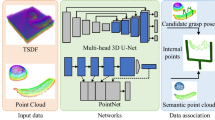Abstract
This paper describes an intuitive approach for a cognitive grasp of a robot. The cognitive grasp means the chain of processes that make a robot to learn and execute a grasping method for unknown objects like a human. In the learning step, a robot looks around a target object to estimate the 3D shape and understands the grasp type for the object through a human demonstration. In the execution step, the robot correlates an unknown object to one of known grasp types by comparing the shape similarity of the target object based on previously learned models. For this cognitive grasp, we mainly deal with two functionalities such as reconstructing an unknown 3D object and classifying the object by grasp types. In the experiment, we evaluate the performance of object classification according to the grasp types for 20 objects via human demonstration.
Similar content being viewed by others
Explore related subjects
Discover the latest articles, news and stories from top researchers in related subjects.References
Tegin J, Ekvall S, Kragic D, Wikander J, Iliev B (2009) Demonstration-based learning and control for automatic grasping. Intel Serv Robotics 2: 23–30
Mae Y, Takahashi H, Ohara K, Takubo T, Arai T (2011) Component-based robot system design for grasping tasks. Intel Serv Robotics 4: 91–98
Perrin DP, Smith CE, Masoud O, Papanikolopoulos N (2000) Unknown object grasping using statistical pressure models. In: Proceedings of the IEEE international conference on robotics and automation
Morales A, Recatalá G, Sanz PJ, Pobil APD (2001) Heuristic vision-based computation of planar antipodal grasps on unknown objects. In: Proceedings of the IEEE international conference on robotics and automation
Taylor G, Kleeman L (2002) Grasping unknown objects with a humanoid robot. In: Australasian conference on robotics and automation
Miller AT, Knoop S, Christensen HI, Allen PK (2003) Automatic grasp planning using shape primitives. In: Proceedings of the IEEE international conference on robotics and automation
Saxena A, Driemeyer J, Ng AY (2008) Robotic grasping of novel objects using vision. Int J Robot Res 27(2): 157–173
Yamazaki K, Tomono M, Tsubouchi T, Yuta S (2004) 3-D object modeling by a camera equipped on a mobile robot. In: Proceedings of the IEEE international conference on robotics and automation
Yamazaki K, Tomono M, Tsubouchi T, Yuta S (2006) A grasp planning for picking up an unknown object for a mobile manipulator. In: Proceedings of the IEEE international conference on robotics and automation
Yamazaki K, Tomono M, Tsubouchi T (2008) Picking up an unknown object through autonomous modeling and grasp planning by a mobile manipulator. Springer, Berlin, p 42
Maeda Y, Ishido N, Kikuchi H, Arai T (2002) Teaching of grasp/graspless manipulation for industrial robots by human demonstration. In: Proceedings of the IEEE international conference on intelligent robots and systems
Ekvall S, Kragic D (2005) Grasp recognition for programming by demonstration. In: Proceedings of the IEEE international conference on robotics and automation
Ekvall S, Kragic D (2004) Interactive grasp learning based on human demonstration. In: Proceedings of the IEEE international conference on robotics and automation
Hueser M, Baier T, Zhang J (2006) Learning of demonstrated grasping skills by stereoscopic tracking of human hand configuration. In: Proceedings of the IEEE international conference on robotics and automation
Choi SI, Park SY, Kim J, Park YW (2008) Multi-view range image registration using CUDA. In: Proceedings of the international technical conference on circuits/systems, computers and communications
Lowe DG (2004) Distinctive image features from scale-invariant keypoints. Int J Comput Vis 60(2): 91–110
Yilmaz A (2006) Object tracking: a survey. ACM Comput Surv 38(4):article 13
Criminisi A, Reid I, Zisserman A (1997) A plane measuring device. Image Vis Comput 17(8): 625–634
Kolmogorov V, Criminisi A, Blake A, Gross G, Rother C (2005) Bi-layer segmentation of binocular stereo video. In: Proceeding conference on computer vision and pattern recognition
Han I, Kim H, Kim K, Park JH (2010) Object segmentation and tracking from sequential stereo images for 3D object modeling. In: Proceedings of Korean conference on HCI Korea
Tangelder JWH, Veltkamp RC (2008) A survey of content based 3D shape retrieval methods. Multimed Tools Appl 39: 441–447
Biasotti S, Falcidieno B, Frosini P, Giorgi D, Landi C, Marini S, Patane G, Spagnuolo M (2007) 3D shape description and matching based on properties of real functions. In: Eurographics
Turk M, Pentland A (1991) Face recognition using eigenface. In: Proceedings of the IEEE conference on computer vision and pattern recognition, pp 586–591
Campbell R, Flynn P (1999) Eigenshapes for 3D object recognition in range data. In: Proceedings of the IEEE conference on computer vision and pattern recognition
Zhao L-W, Luo S-W, Liao L-Z (2004) 3D object recognition and pose estimation using kernel PCA. In: Proceedings of the international conference on machine learning and cybernetics
Author information
Authors and Affiliations
Corresponding author
Rights and permissions
About this article
Cite this article
Kim, H., Han, I., You, BJ. et al. Towards cognitive grasping: modeling of unknown objects and its corresponding grasp types. Intel Serv Robotics 4, 159–166 (2011). https://doi.org/10.1007/s11370-011-0088-5
Received:
Accepted:
Published:
Issue Date:
DOI: https://doi.org/10.1007/s11370-011-0088-5




